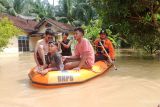"A mitigation study indicates that the most important action when a big earthquake strikes is to stay away from the coast and find a higher place," he noted here, Monday.
Permanajati, coordinator of the geological disaster division at the university's Mitigation Center, remarked that people should install some disaster warning applications from the Meteorology, Climatology, and Geophysical Agency (BMKG) in order to receive every real and accurate information quickly.
"Then, the next step is to build or look for a place to protect ourselves or a meeting point," he remarked.
Permanajati, who teaches engineering geology and disaster mitigation, elaborated that the meeting point should be clear regarding the position, and segregation should be on the basis of the number of people at a certain place.
"Hence, when an earthquake or other incident takes place, people already know which direction they should head to in order to reach safe places," he remarked, adding that evacuation routes should also be provided to make the evacuation process swifter, easier, and safer.
"The evacuation point is recommended to be farther away from the beach, or more than three to four kilometers. With a prediction of 25 minutes before tsunamis take place after an earthquake hits, the time is sufficient to run away as far as three to four kilometers from the sea. It is preferable to use vehicles," he stated.
The Indonesian Geological Association’s member suggested that the government can build a wide road perpendicular to the coast, with a distance of three to four kilometers or more for evacuation routes. This facility can make the evacuation process easier for people to leave the coastal areas.
"I think those actions and steps could be taken. I suggest the government to build roads or access away from the coasts, with a distance of three to four kilometers or more, directed to safe places. Coastal monitoring and early warning alarms should also be provided and operated well," Permanajati asserted.
EDITED BY INE








